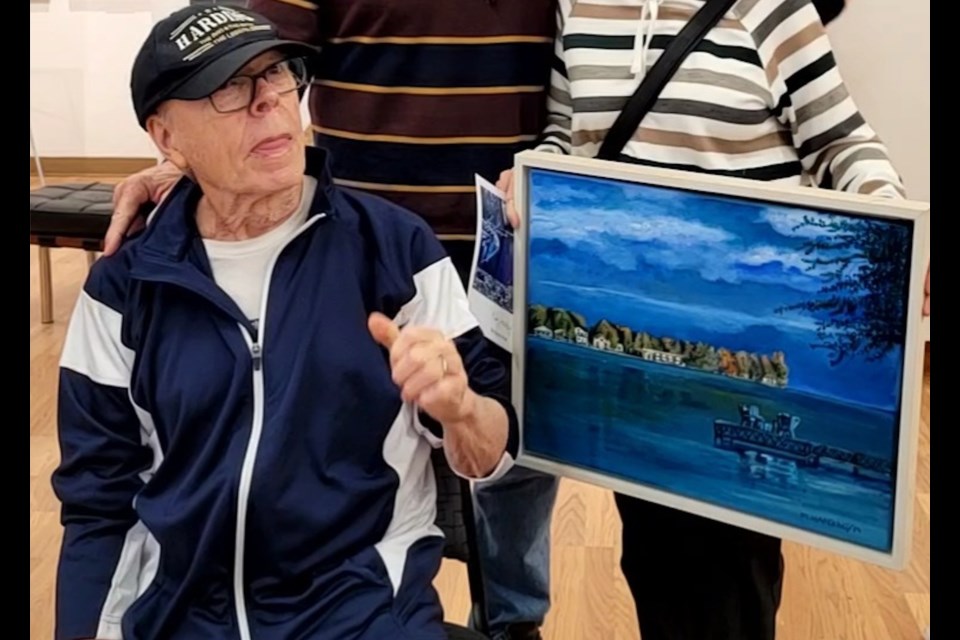For more than 60 years, Orillia resident and artist Michael Harding has developed a unique touch to the art of painting, but his art skills were challenged drastically when, about five years ago, he was diagnosed with Parkinson’s disease.
“I can’t do a lot of things now as I used to beforehand. I’ve had to stop painting. I can’t write emails on the computer without duplicating letters, and that just frustrates me a lot,” Harding said.
Parkinson’s disease is a brain disorder that causes unintended or uncontrollable movements, such as shaking, stiffness, and difficulty with balance and co-ordination.
Looking back on the “good ol’ days,” as he calls it, Harding, at the age of four, started drawing 3D cars for fun; people around him, he recalls, thought it was weird. For him, it wasn’t weird, but rather the start of a lifelong passion — painting.
After growing up and continuing his passion, he made his way to the University of Toronto Scarborough for art classes. There, his self-learned art skills, on top of the professional skills that were being taught, accelerated his painting career.
His works were so impressive, they ended up in the Canadian National Exhibition.
His career also came with some sad times. While he was at university, the art class he was in hosted a gallery show, and one of Harding’s four-by-four-foot paintings was stolen.
“Funny thing about that was, 10 years later, I took another course with the same professor, and he recognized me and had a copy of the stolen painting that I had done. So, the professor took the copy out of a box and showed me my original painting,” Harding recalled.
After graduating from university, he continued his art career. He started painting on his own for people, weddings, and events, but he soon realized it was too much, so he decided to keep his art in the family.
Over the years, Harding developed his skills and branched out into different types of paintings.
“I got into the style of acrylic painting, which, after trying it, I never liked,” he said.
“I eventually got into other styles and came out with two styles I liked. One was pen and ink and the other one was watercolour.”
Using these styles, over time, he created more than 150 paintings. Some were small, like greeting card designs, and others large enough to be mounted on walls.
One day, he noticed his hand twitch. At first, he didn't think anything of it, but over the next couple of days, it continued. He eventually went to see a specialist in Huntsville, and he was diagnosed with Parkinson’s disease.
After being diagnosed, he continued painting until the disease became too much for him to continue.
“I’ve had to turn down a lot of stuff and it’s limited my ability to do stuff,” he said.
His wife, Rose, knew how hard the disease was on Harding. She decided to organize a special art gallery walk-through of all of his paintings at the Orillia Museum of Art and History this past Saturday.
Harding had more than 100 paintings on display.
“I thought it went pretty well,” said Harding. “Even my ski buddies, who I haven’t skied with in a while, came out to the gallery.”
“I am so proud of Michael,” said his wife. “He’s full of positive energy, and everything around him is positive. He feels the texture and paints the texture and captures the essence of the landscape. (It was the) best time in three years to see Michael and all his artwork. It was like a big family and friends get-together.”
Harding always signs his artwork.
“Signing is always hard, but I still try to master my original signature, even with the dot at the end of it,” he said.
Any painting he has created since his diagnosis includes “PD” at the end of his signature, indicating it was done while he was battling Parkinson’s disease.
His advice to artists, experienced or not, is to take their art supplies everywhere they go. He says you never know when you might be in the perfect spot for a painting, and if you don’t have your supplies with you, you might miss a once-in-a-lifetime moment.
